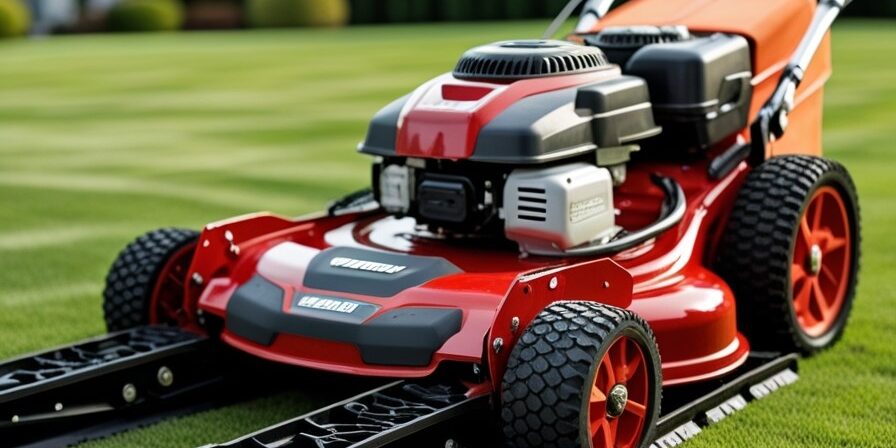Are you tired of your lawn mower getting stuck in wet grass or struggling on uneven terrain? Tracks for lawn mowers might be the solution you’re looking for. These innovative additions to your mowing equipment can transform your lawn care experience, making it easier and more efficient. In this article, we’ll explore everything you need to know about tracks for lawn mowers, from their types and benefits to installation tips and cost considerations.
Types of Lawn Mower Tracks
 When it comes to tracks for lawn mowers, there are several options available:
When it comes to tracks for lawn mowers, there are several options available:
-
- Rubber Tracks: These are the most common type, offering a good balance of durability and traction.
- Steel Tracks: Ideal for heavy-duty applications, steel tracks provide excellent durability but can be harder on delicate surfaces.
- Hybrid Tracks: Combining the benefits of rubber and steel, hybrid tracks offer a balance of durability and surface protection.
- All-Season Tracks: Designed to perform well in various weather conditions, from wet grass to light snow.
Each type has its own set of advantages, and the best choice depends on your specific needs and lawn conditions.
Benefits of Using Tracks on Lawn Mowers
 Switching to tracks for your lawn mower can offer numerous advantages:
Switching to tracks for your lawn mower can offer numerous advantages:
-
- Improved Traction: Tracks provide better grip on various surfaces, reducing slippage and improving maneuverability.
- Reduced Ground Pressure: The larger surface area of tracks distributes the mower’s weight more evenly, minimizing lawn damage.
- Enhanced Stability: Tracks offer a lower center of gravity, improving stability on slopes and uneven terrain.
- Better Performance in Wet Conditions: Unlike wheels, tracks can navigate through wet grass and muddy areas with ease.
- Increased Versatility: Tracks allow your mower to handle a wider range of terrains and conditions.
Factors to Consider When Choosing Tracks
 Selecting the right tracks for your lawn mower involves considering several factors:
Selecting the right tracks for your lawn mower involves considering several factors:
-
- Mower Compatibility: Ensure the tracks are compatible with your specific mower model.
- Terrain Type: Consider the primary terrain you’ll be mowing (flat, hilly, wet, etc.).
- Track Material: Choose between rubber, steel, or hybrid based on your needs and budget.
- Width and Length: The dimensions of the tracks affect maneuverability and ground pressure.
- Weight Capacity: Make sure the tracks can support the weight of your mower and any attachments.
- Ease of Installation: Look for tracks that are easy to install and remove if needed.
Installation and Maintenance
 Installing tracks on your lawn mower can be a straightforward process:
Installing tracks on your lawn mower can be a straightforward process:
-
- Consult your mower’s manual for any specific instructions or precautions.
- Remove the existing wheels carefully.
- Attach the track system according to the manufacturer’s guidelines.
- Ensure all bolts and connections are secure.
- Test the mower on a flat surface before tackling challenging terrain.
For maintenance:
-
- Regularly inspect the tracks for wear and tear.
- Clean the tracks after each use to prevent debris buildup.
- Lubricate moving parts as recommended by the manufacturer.
- Check and adjust track tension periodically.
Proper installation and maintenance will extend the life of your tracks and ensure optimal performance.
Top Brands for Lawn Mower Tracks
 Several reputable brands offer quality tracks for lawn mowers:
Several reputable brands offer quality tracks for lawn mowers:
-
- Camso: Known for their durable rubber tracks.
- Mattracks: Offers a wide range of track systems for various applications.
- Soucy Track: Specializes in tracks for agricultural and lawn care equipment.
- ATI Products: Provides innovative track solutions for lawn mowers and other vehicles.
Before making a purchase, research customer reviews and compare specifications to find the best fit for your needs.
Comparing Tracks to Wheels
 While tracks offer many advantages, it’s essential to consider how they compare to traditional wheels:
While tracks offer many advantages, it’s essential to consider how they compare to traditional wheels:
| Aspect | Tracks | Wheels |
| Traction | Superior on most surfaces | Good on dry, even terrain |
| Maneuverability | Excellent on varied terrain | Better for tight turns on flat surfaces |
| Ground Pressure | Lower, less lawn damage | Higher, potential for ruts |
| Maintenance | Requires regular cleaning and tension checks | Generally lower maintenance |
| Cost | Initially higher | More affordable upfront |
| Versatility | Suitable for various conditions | Best for standard lawn care |
Cost Considerations
 Investing in tracks for your lawn mower involves several cost factors:
Investing in tracks for your lawn mower involves several cost factors:
-
- Initial Purchase: Tracks are generally more expensive than wheels.
- Installation: You may need professional installation, adding to the cost.
- Maintenance: Regular maintenance can help avoid costly repairs.
- Fuel Efficiency: Tracks may slightly increase fuel consumption due to added weight.
- Long-term Savings: Improved performance and reduced lawn damage can lead to savings over time.
While the upfront cost may be higher, many users find that the benefits outweigh the initial investment, especially for challenging lawn care situations.
Conclusion
Tracks for lawn mowers can significantly enhance your mowing experience, particularly if you deal with challenging terrain or wet conditions. By improving traction, stability, and versatility, they allow you to maintain your lawn more effectively and with less effort. When choosing tracks, consider your specific needs, mower compatibility, and budget. With proper selection, installation, and maintenance, tracks can be a valuable addition to your lawn care equipment.
Remember to consult with a lawn care professional or the manufacturer if you have any doubts about compatibility or installation. Happy mowing!








